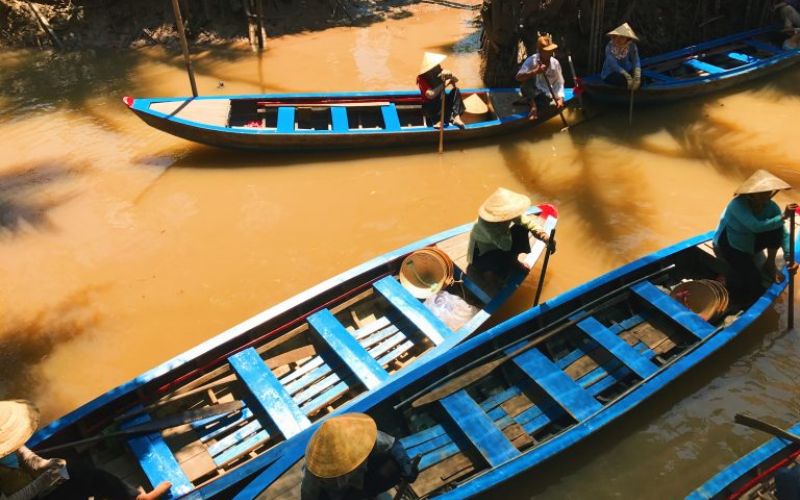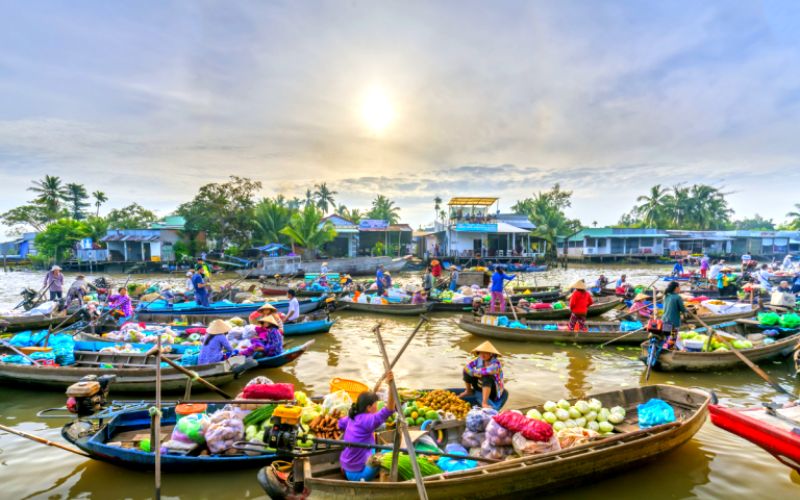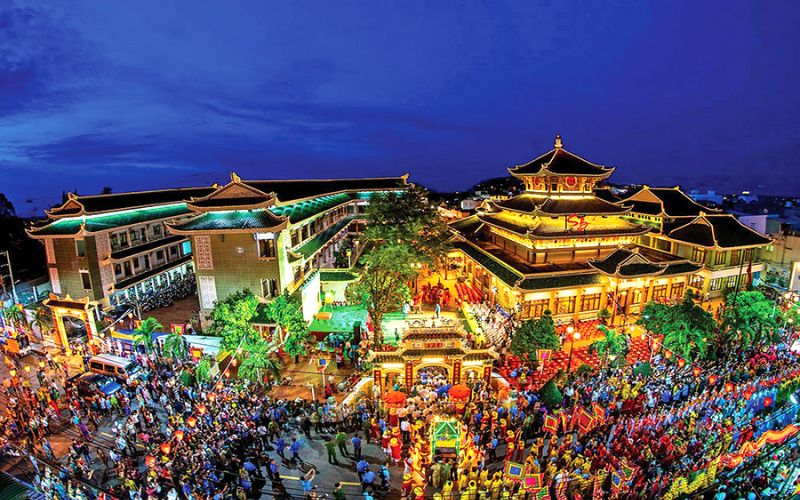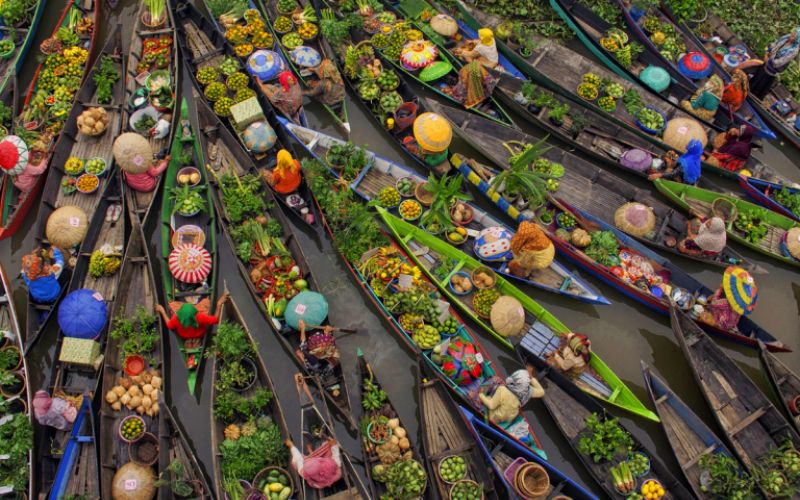Together with Ho Chi Minh City, Mekong Delta is a must-visit place on your trip to Southern Vietnam, especially for those in search of an eco-tourism experience. If you are planning a visit to this natural paradise of Vietnam, read and learn by heart the following Mekong Delta travel guide so that you can prepare essential things and enjoy your trip to the fullest.
General Information
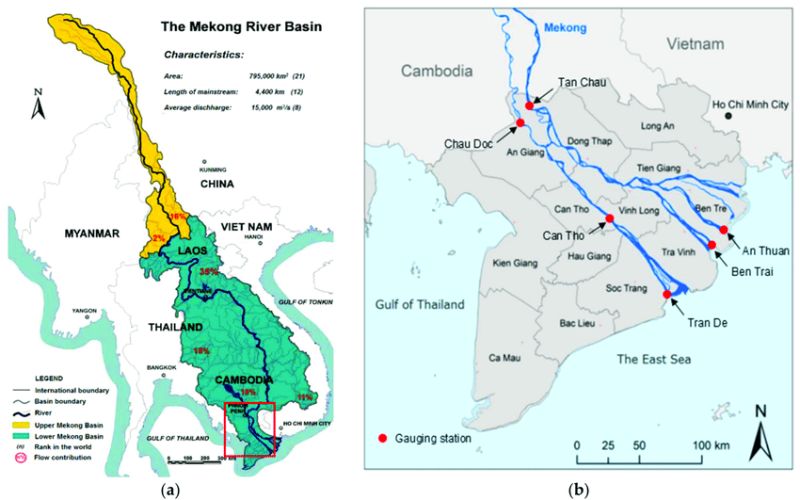
Mekong Delta Location
The Mekong River connects five Southeast Asian countries: Vietnam, Laos, Cambodia, Thailand, and Myanmar. The Mekong Delta (or ‘Nine Dragon River Delta’) is formed by river sediments, and the process continues to this day, providing silt deposits to extend the delta by nearly 79m per year. Because of this process, the land is rich in agricultural and fishery products such as rice, fruits, coconut, shrimp, and fish. Despite being primarily rural, the region is one of the most populated and agriculturally developed.
Taking a tour of Mekong Delta, you can visit floating markets, orchards, and fish farms. Those interested in learning about the various cultures of Vietnam can visit the beautiful Khmer pagodas in Soc Trang and Tra Vinh. The Khmers, who make up a sizable portion of the region’s population, have preserved their unique culture and magnificent architecture. For a longer journey, head west to Rach Gia and take a boat to Phu Quoc Island.
Mekong Delta Weather

Weather in Mekong Delta Vietnam
The Mekong Delta welcomes you at any time of year; each season will undoubtedly provide you with unique types of pleasure and satisfaction. The floating season, which runs from September to December, is the best time to visit the Mekong Delta.
- Floating season (September – December): During this time, Mekong Delta experiences a pleasant climate with very low rains. You can go fishing in our traditional wooden boats, discover pristine nature and spend time in some orchards.
- Rainy season (May – October): It is not a bad idea to visit Cai Be during the rainy season because the rains are brief and will not disrupt your trip.
- Dry season (January – April): It is hot and dry during this time, but it is harvest season here, and you can participate in fruit-picking activities with the locals.
Things to Do in Mekong Delta
- Ride a boat through the canals
- Visit some local factories that make coconut candy, brick, traditional cakes, and so on
- Visit Khmer temples and pagodas
- Picking fruit in orchards
- Visit floating and night markets
- Take a Vietnam Mekong cruise trip
Places to visit in Mekong Delta
1. My Tho
-

A floating market in My Tho
My Tho, only 70km from Ho Chi Minh City, is one of the destinations not to be missed during your trip to the Mekong Delta.
Getting to & around My Tho
It usually takes 1.5 hours for you to travel from Ho Chi Minh City to My Tho by bus. Taxis, xe om (it is best to negotiate the price), private cars, and boats are the most common modes of transportation in the city center.
Places to visit in My Tho
- Vinh Trang Pagoda: With an ancient and unique architectural style, Vinh Trang Pagoda is one of the most beautiful pagodas in Tien Giang Province. It was built in the nineteenth century and receives a large number of visitors each year. Vinh Trang Pagoda is home to three massive Buddhist statues in three different poses: standing, lying, and sitting.
- Cai Be Floating Market: Cai Be Floating Market is the most well-known tourist attraction in My Tho. Visitors who come here will be blown away by the beauty of the Mekong River in our country’s west.
- Dong Tam Snake Farm: With over 400 snake species, this is one of Vietnam’s largest snake farms. Every day, thousands of visitors come to learn about snakes and purchase products made from these animals.
- Fruit Orchards: Orchards are undeniably must-see attractions in the Mekong Delta. You can breathe in the fresh air and eat delicious fruits like rambutan, durian, and mango.
Food to eat in My Tho
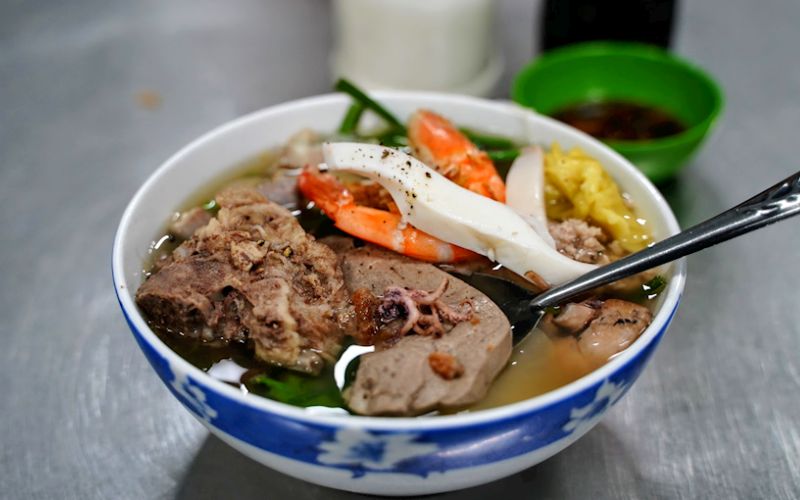
Hu Tieu My Tho
- Hu Tieu My Tho (rice noodle soup)
- Hoa Loc mango
- Vietnamese tri-spine horseshoe crab
2. Ben Tre
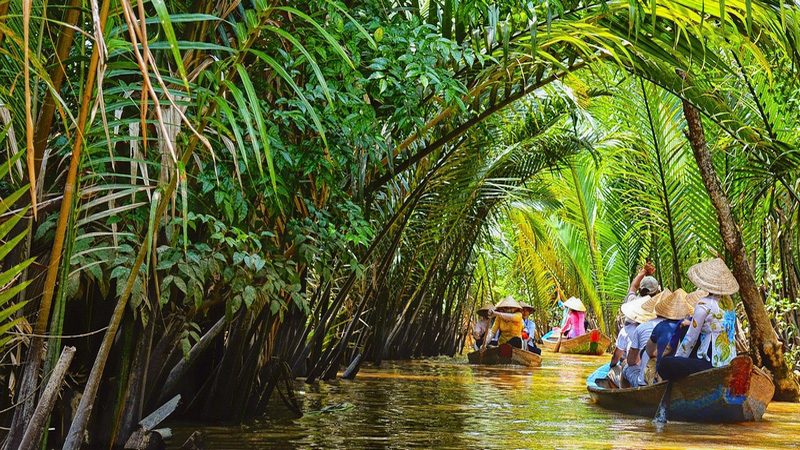
Ben Tre
Ben Tre is located 85 kilometers southwest of Ho Chi Minh City and has a population of 124,499 people. The Rach Mieu Bridge connects it to the surrounding provinces. Ben Tre is a Mekong Delta province known as the Dong Khoi Revolution’s homeland and the Coconut Land.
How to get to & around Ben Tre
The cheapest way to travel from Ho Chi Minh City to Ben Tre is by shuttle bus. Some bus companies offer free pick-up to bus stations no more than 5 kilometers away. Most buses from Ho Chi Minh City to Ben Tre depart from Mien Tay bus station and arrive in Ben Tre’s city center. You will need to take another bus to your destination from the Ben Tre bus station. Besides, you should consider a private car. It is the best way to travel from Ho Chi Minh to Ben Tre because the trip takes only 1.5 hours.
Places to visit in Ben Tre
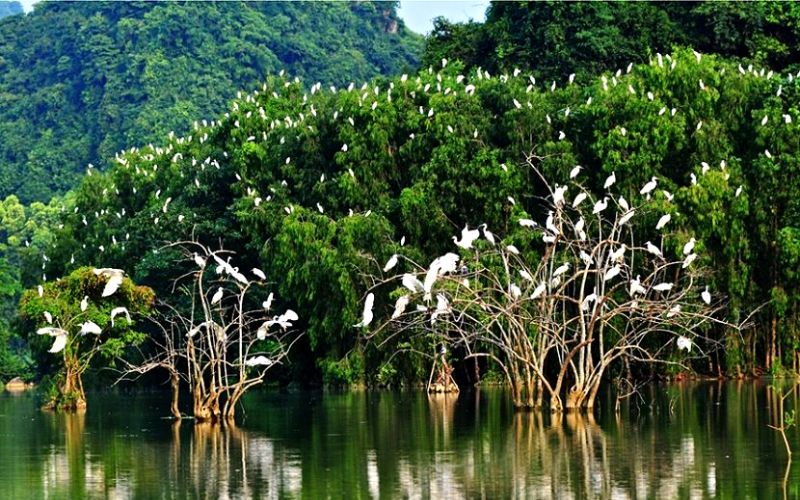
Vam Ho bird sanctuary
- Vam Ho Bird Sanctuary: This sanctuary is home to nearly 500,000 storks, cauldrons, and other wild birds and is located in the communes of My Hoa and Tan Xuan in the Ba Tri district. This sanctuary not only houses a variety of exotic bird species, but it also has a cafe and lodging.
- Orchard Of Cai Mon Fruit: Cai Mon craft village offers millions of seedlings of fruits and vegetables such as durian, mango, pepper, and citrus. When you visit Cai Mon Orchard, you will be amazed at the variety of fruit trees and flowers available.
- Con Quy (Turtle Islet): When visiting Ben Tre, it is impossible not to mention the Turtle Islet (Con Quy). What attracts visitors is that Quy Island still retains a wild beauty, with many perennial fruit gardens planted in rows.
Food to eat in Ben Tre
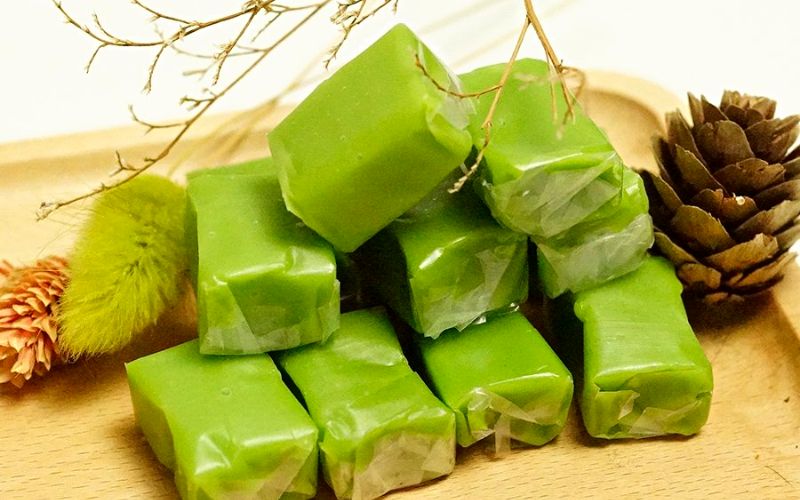
Coconut candy
- Coconut candy: Coconut candy is a well-known specialty in Ben Tre. Coconut milk and maltose are the main ingredients in this candy. It’s tasty, has a greasy smell, and is slightly sweet in a way that you won’t find anywhere else.
- Crab porridge: Fresh crabs are peeled in order to obtain bricks for cooking the broth, and the crab meat is pureed. To preserve the flavor of the dish, the crab porridge should be cooked in an earthen pot. Visitors will be unable to resist the extremely appealing and delicious taste.
- Coconut tuber salad: Coconut tubers are thinly sliced into long fibers and mixed with the ingredients listed above, along with spices. This inexpensive dish tastes sweet and sour, as well as crispy and fragrant.
3. Vinh Long
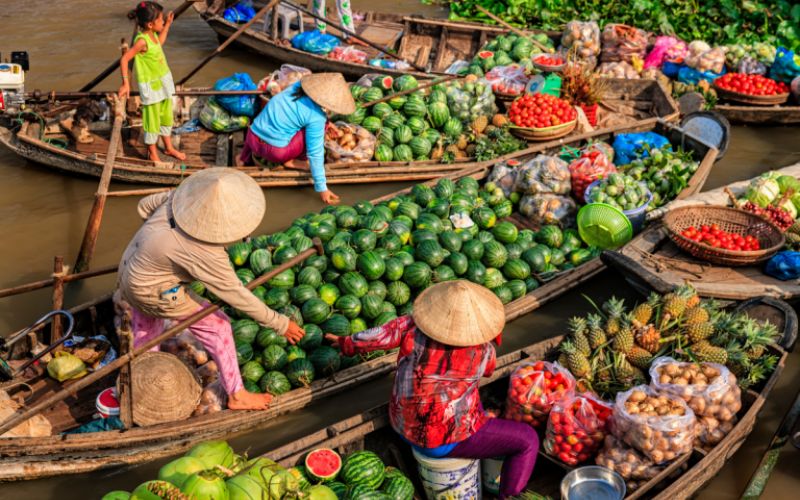
Tra On floating market in Vinh Long
Located 140km from Ho Chi Minh, Vinh Long is an excellent spot for learning about riparian culture. Vinh Long’s climate is cool and pleasant all year, but summer is the best time to visit because the orchards are at their lushest. Fish and tropical fruits are among Vinh Long’s specialties.
Getting to & around Vinh Long
The most common way to get to Vinh Long is by car or bus from Ho Chi Minh City which takes you over 2.5 hours. In Vinh Long, you can go around by taxi, private car, or bicycle.
Places to visit in Vinh Long
- Vinh Sang Tourist Area: Vinh Sang Tourist Area combines a fruit orchard with a handicraft village. Many activities are available here, including fishing, fruit picking, and biking.
- Vinh Long Orchard: When visiting Vinh Long, don’t forget to stop by an orchard. Chin Hoan’s Rambutan Orchard, Tam Ho’s Longan Orchard, My Hoa’s Grapefruit Orchard, and others are among the largest orchards in the area. In the garden, you can pick and eat fruit.
Food to eat in Vinh Long
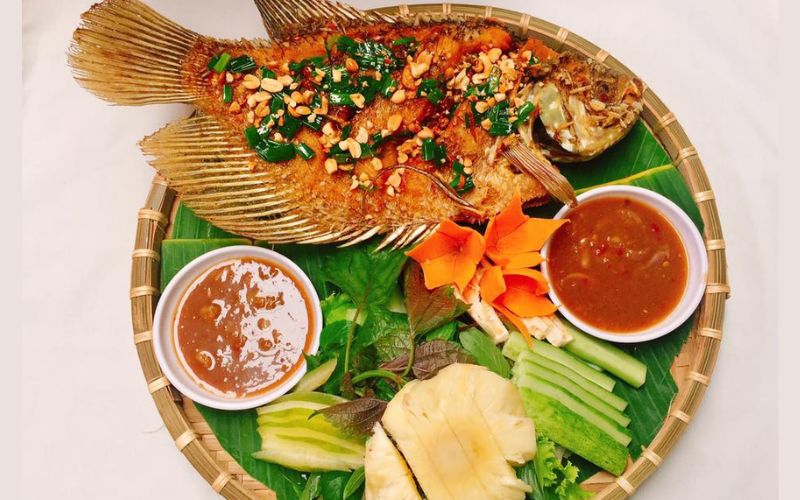
Deep Fried Elephant Ear Fish
- Hu Tieu My Tho (rice noodle soup)
- Deep Fried Elephant Ear Fish
- Rambutan Jam
4. Can Tho
-

Can Tho
Can Tho is 170 km from Ho Chi Minh, in the heart of the Mekong Delta, surrounded by rivers and canals. Can Tho is one of the region’s largest and most popular tourist destinations. Up to now, this city has welcomed over 9 million tourists.
Weather in Can Tho
Can Tho has two distinct seasons: the rainy season (May to November) and the dry season (December to April) (December – April). The temperature is 27 degrees Celsius on average. If you visit Can Tho in the summer, you will have the opportunity to sample a variety of succulent fruits.
Getting to & around Can Tho
Can Tho has two distinct seasons: the rainy season (May to November) and the dry season (December to April) (December – April). The temperature is 27 degrees Celsius on average. If you visit Can Tho in the summer, you will have the opportunity to sample a variety of succulent fruits.
Places to visit in Can Tho
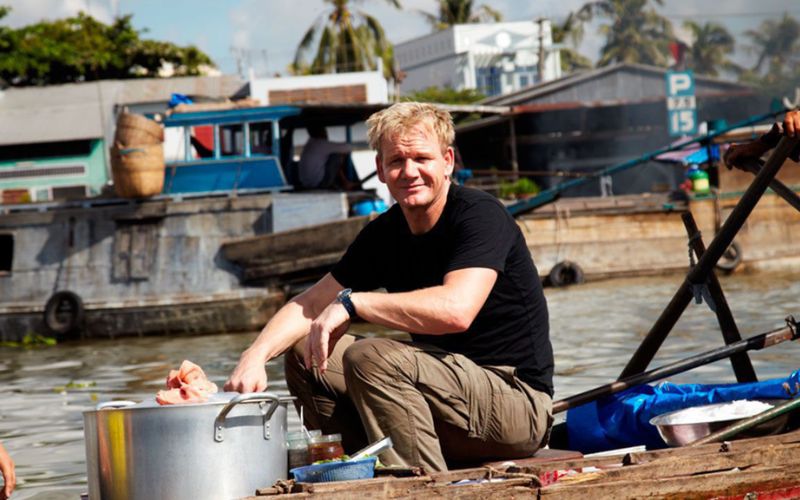
Gordon Ramsay on a floating board in Cai Rang
- Cai Rang Floating Market: Visiting Cai Rang Floating Market is a must-do activity for any tourist visiting Vietnam. The best time to visit this location is between 5-8 am, so it is best to spend the night in Can Tho and then visit Cai Rang the next morning.
- Binh Thuy Ancient House: The Duong family constructed the Binh Thuy Ancient House in 1870. The architecture of this home was influenced by the French style. This location was used to film dozens of famous films, including a French director named J. Annaud’s ‘The Silt Ways,’ ‘Bac Lieu Mandarin’s son,’ and ‘The Lover.’
- Bang Lang Stork Sanctuary: It is approximately 50 kilometers from Can Tho’s downtown. This 1.5-hectare stork garden is home to thousands of different storks. Observing the stork will astound visitors, as will the relaxed and laid-back atmosphere of a bucolic setting.
- My Khanh Fruit Orchard: This orchard is located in Can Tho Province, between Cai Rang floating market and Phong Dien. My Khanh fruit garden contains over 20 different types of Southwest fruits such as rambutan, durian, dragon fruit, and so on.
- Ong Pagoda: This was once the site of various cultural and religious activities for the Chinese community in Can Tho. Ong Pagoda was built in 1894, and its unique architecture has survived to this day.
Food to eat in Can Tho
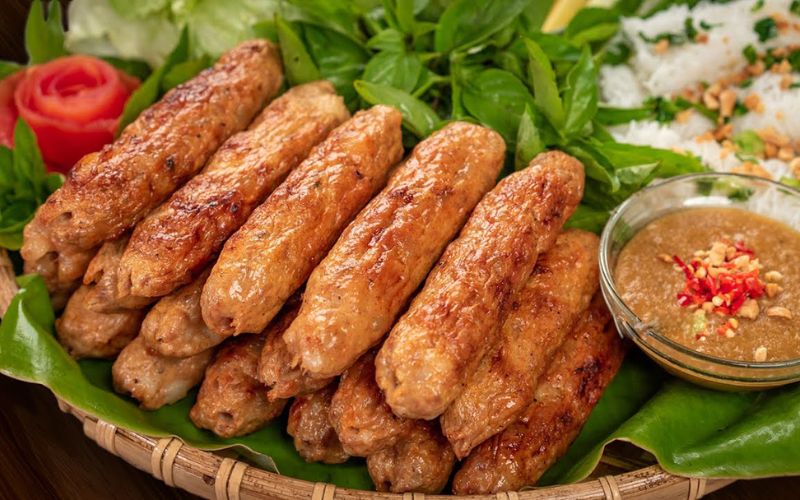
Nem nuong
- Oc nuong tieu (Grilled Green Pepper Snails)
- Nem Nuong (Grilled rolls)
- Grilled fish
- Banh Xeo (Vietnamese pancake)
5. Chau Doc
-

Chau Doc
Chau Doc is the main tourist destination of An Giang Province, approximately 220 kilometers from Ho Chi Minh City and 117 kilometers from Can Tho. The pleasant weather makes Chau Doc a popular tourist destination all year.
From here, you can take a boat trip to some fish farms and the Tra Su Capujut forest. Visit a temple or pagoda to learn about Khmer history and culture.
Getting to & around Chau Doc
Because Chau Doc lacks an airport, the best way to get to Chau Doc from other cities in Northern and Central Vietnam, such as Hanoi, Hue, and Da Nang, is to fly to Ho Chi Minh City and then take a bus or car to Chau Doc.
There are numerous modes of transportation available in Chau Doc, including bicycle, bus, taxi, motorbike taxi (xe om), and private car. A boat trip is required if you want to visit canals or fishing villages.
Places to visit in Chau Doc
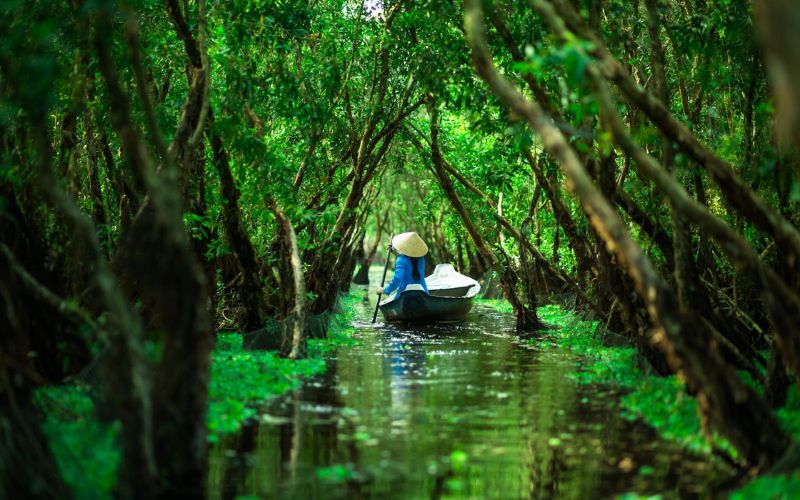
Tra Su Cajuput Forest
- Sam Mountain: With an area of over 280 hectares, Sam Mountain is a must-see in Chau Doc. The mountain is covered in shady trees all year. Sam Mountain is also a collection of temples, ancient pagodas, and caves that form a beautiful landscape.
- Ba Chua Xu Temple: The Ba Chua Xu Temple is a well-known religious site in the Mekong Delta. The most popular time to visit is from the first to third lunar month when a spring festival is held.
- Phuoc Dien Pagoda (or Hang Pagoda): Built between 1840 and 1845 on Sam Mountain, Phuoc Dien Pagoda is a religious destination that houses a 1000-arm and 1000-eye Guan Yin statue.
- Tra Su Cajuput Forest: With a diverse range of flora and fauna, Tra Su Capujut Forest in An Giang is an ideal ecotourism destination. The best way to explore this area is by boat.
- The Forbidden Mountain (Nui Cam): is 37 kilometers from Chau Doc and has an elevation of 705 meters. It is the highest peak in the Mekong Delta. Thien Cam Son Mountain is another name for this location, which is home to Asia’s largest Maitreya statue.
- Chau Doc Floating Market: This market sells a variety of tropical fruits. The best time to visit Chau Doc Floating Market is between 6-7 a.m. when the market is busier.
Food to Eat in Chau Doc
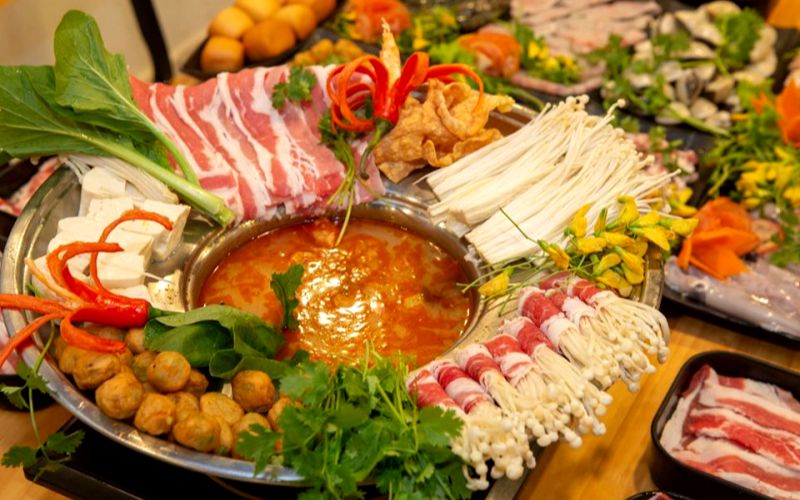
Fish sauce hotpot
- Bun ca (Fish vermicelli)
- Fish sauce hotpot
- Banh bo (Beefcake)
- Goi Sau Dau (Sau Dau salad)
Floating Markets in Mekong Delta
-

floating markets in Vietnam
You should spend time at some of the Mekong Delta’s most lively and colorful floating marketplaces, which are listed below.
Cai Rang Floating Market (Can Tho)
The market is only 6 kilometers from Can Tho and can be reached by boat in 30 minutes from the Ninh Kieu Wharf. Cai Rang is the Mekong Delta’s largest floating market. The market is busy in the early morning until 9 a.m., so if you want to watch the market, get there early. You can taste specialty or coffee on the boat in addition to purchasing fruits and products.
Cai Be Floating Market (Tien Giang)
There is no boat and no seller in Cai Be market after 8 a.m., so you must arrive very early. Cai Be Floating Market vendors primarily sell fruits, but you can also find household goods and other delicious local dishes.
Long Xuyen Floating Market (An Giang)
Long Xuyen market, located 2 kilometers from the city center, is smaller than other markets, but its products are diverse. Long Xuyen market is a great place to visit if you want to see a bustling floating market while also learning about local life.
Tra On Floating Market (Vinh Long)
Tra On’s market retains the characteristics of a wholesale market, with agricultural products such as potatoes and cucumbers, as well as fruits such as Tan Thanh oranges and Luc Si Thanh durians.
Pagodas and Temples in Mekong Delta
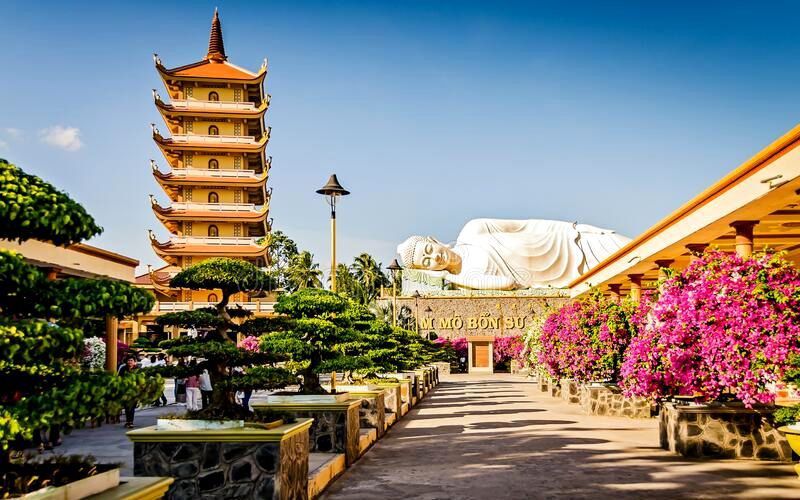
Reclining Buddha Statue
You will have the opportunity to visit many beautiful pagodas during your trip to the Mekong Delta. Every year, a large number of pilgrims and tourists visit these spiritual and religious sites.
Vinh Trang Pagoda (My Tho)
When visiting My Tho, Vinh Trang is a must-see pagoda. Vinh Trang, built-in 1933 by Hue craftsmen, is a fusion of Cambodian and French architecture. In the courtyard of the pagoda, there are also hundreds of beautiful ornamental plants, bonsai, lotus ponds, and many shady trees.
Xiem Can Pagoda (Bac Lieu)
This pagoda is 7 kilometers from Bac Lieu. It was built in the nineteenth century and covers an area of 50,000 ha. The Xiem Can Pagoda is magnificent, with its two distinct colors, yellow and red. The vaults, walls, pillars, and stairs all reflect Khmer architecture.
Phat Lon Pagoda (An Giang)
The Phat Lon Pagoda (Big Buddha) is situated in the heart of Cam Mountain (the Forbidden Mountain), which is well-known for its magnificent sites and spiritual myths. The 33.6-meter-tall Buddha Maitreya statue is the pagoda’s most notable feature.
Kien An Cung Pagoda (Sa Dec)
Kien An Cung Pagoda, also known as Ong Quach Pagoda, is featured in Marguerite Duras’ famous French novel ‘L’amant’ (The Lover). It was built between 1924 and 1927 for the Fujian Chinese community who lived in Sa Dec at the time.
We hope the information in the article “Vietnam – Mekong Delta travel guide” will be helpful to you. If you want to have more information and ideas to build an unforgettable itinerary in this wonderful land do not hesitate to contact us!

